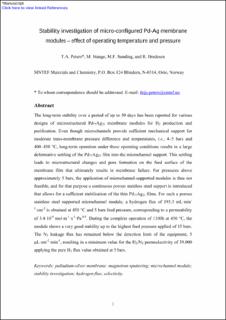| dc.contributor.author | Peters, Thijs | |
| dc.contributor.author | Stange, Marit Synnøve Sæverud | |
| dc.contributor.author | Sunding, Martin Fleissner | |
| dc.contributor.author | Bredesen, Rune | |
| dc.date.accessioned | 2020-12-21T10:03:51Z | |
| dc.date.available | 2020-12-21T10:03:51Z | |
| dc.date.created | 2015-04-14T16:12:43Z | |
| dc.date.issued | 2015 | |
| dc.identifier.citation | International journal of hydrogen energy. 2015, 40 (8), 3497-3505. | en_US |
| dc.identifier.issn | 0360-3199 | |
| dc.identifier.uri | https://hdl.handle.net/11250/2720546 | |
| dc.description.abstract | The long-term stability over a period of up to 50 days has been reported for various designs of microstructured Pd77Ag23 membrane modules for H2 production and purification. Even though microchannels provide sufficient mechanical support for moderate trans-membrane pressure difference and temperatures, i.e., 4–5 bars and 400–450 °C, long-term operation under these operating conditions results in a large deformative settling of the Pd77Ag23 film into the microchannel support. This settling leads to microstructural changes and pore formation on the feed surface of the membrane film that ultimately results in membrane failure. For pressures above approximately 5 bars, the application of microchannel-supported modules is thus not feasible, and for that purpose a continuous porous stainless steel support is introduced that allows for a sufficient stabilisation of the thin Pd77Ag23 films. For such a porous stainless steel supported microchannel module, a hydrogen flux of 195.3 mL cm−2 min−1 is obtained at 450 °C and 5 bars feed pressure, corresponding to a permeability of 3.4·10−8 mol m−1 s−1 Pa−0.5. During the complete operation of 1100 h at 450 °C, the module shows a very good stability up to the highest feed pressure applied of 15 bars. The N2 leakage flux has remained below the detection limit of the equipment, 5 μL cm−2 min−1, resulting in a minimum value for the H2/N2 permselectivity of 39.000 applying the pure H2 flux value obtained at 5 bars. | en_US |
| dc.language.iso | eng | en_US |
| dc.publisher | Elsevier | en_US |
| dc.rights | Attribution-NonCommercial-NoDerivatives 4.0 Internasjonal | * |
| dc.rights.uri | http://creativecommons.org/licenses/by-nc-nd/4.0/deed.no | * |
| dc.subject | Selectivity | en_US |
| dc.subject | Hydrogen flux | en_US |
| dc.subject | Stability investigation | en_US |
| dc.subject | Microchannel module | en_US |
| dc.subject | Magnetron sputtering | en_US |
| dc.subject | Palladium–silver membrane | en_US |
| dc.title | Stability investigation of micro-configured Pd-Ag membrane modules - Effect of operating temperature and pressure | en_US |
| dc.type | Peer reviewed | en_US |
| dc.type | Journal article | en_US |
| dc.description.version | acceptedVersion | en_US |
| dc.rights.holder | This is the authors’ accepted and refereed manuscript to the article.This manuscript version is made available under the CC-BY-NC-ND 4.0 license http://creativecommons.org/licenses/by-nc-nd/4.0/ | en_US |
| dc.source.pagenumber | 3497-3505 | en_US |
| dc.source.volume | 40 | en_US |
| dc.source.journal | International journal of hydrogen energy | en_US |
| dc.source.issue | 8 | en_US |
| dc.identifier.doi | 10.1016/j.ijhydene.2014.11.019 | |
| dc.identifier.cristin | 1237169 | |
| dc.relation.project | Norges forskningsråd: 216056 | en_US |
| dc.relation.project | Norges forskningsråd: 215666 | en_US |
| cristin.unitcode | 7401,80,3,2 | |
| cristin.unitcode | 7401,80,6,2 | |
| cristin.unitcode | 7401,80,3,0 | |
| cristin.unitname | Tynnfilm og membranteknologi | |
| cristin.unitname | Materialfysikk. Oslo | |
| cristin.unitname | Bærekraftig energiteknologi | |
| cristin.ispublished | true | |
| cristin.fulltext | postprint | |
| cristin.qualitycode | 2 | |

